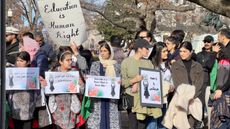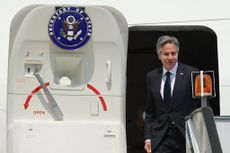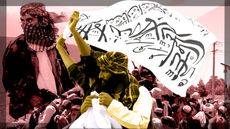What does the Taliban stand for?
Militants tell women to stay at home as radical overhaul gets underway
The Taliban’s return to power in Afghanistan has been celebrated by many Islamist extremist groups, but not Islamic State.
Instead Isis “basically called the Taliban a stooge of the US” and said it “was handed Afghanistan on a silver platter” by the American government, a BBC expert on extremist messaging, Mina Al-Lami, told NPR.
Nor is it only a war of words, said The Guardian foreign correspondent Jason Burke: “fierce battles” have broken out between the Taliban and local Isis affiliates in Afghanistan.
Subscribe to The Week
Escape your echo chamber. Get the facts behind the news, plus analysis from multiple perspectives.

Sign up for The Week's Free Newsletters
From our morning news briefing to a weekly Good News Newsletter, get the best of The Week delivered directly to your inbox.
From our morning news briefing to a weekly Good News Newsletter, get the best of The Week delivered directly to your inbox.
And days after rolling into Kabul, the Taliban claimed to have taken the former head of Islamic State in South Asia from an Afghan prison and executed him “on the spot”, The Wall Street Journal (WSJ) reported.
The latest
Two months after the Taliban seized power after the US and Nato’s chaotic withdrawal, “the new Islamist rulers in Kabul are threatened by an insurgency launched by Islamic State-Khorasan Province”, better known as Isis-K, said the Financial Times.
The offshoot group has detonated bombs at Kabul airport and two Shia mosques, killing hundreds, and has attacked Taliban convoys.
Its “hardline stance has proved attractive to disgruntled Taliban fighters” who are “dismayed at the new regime’s reluctance to impose tougher restrictions on women and its diplomatic overtures to countries such as the US, China and Russia”, the paper added.
Some US trained former soldiers and intelligence officers have also turned to Isis as “the only force currently challenging the country’s new rulers”, according to The Wall Street Journal.
The number of new recruits is “relatively small”, the paper said, but has furnished Isis with “critical expertise in intelligence gathering and warfare techniques, potentially strengthening the extremist organisation’s ability to contest Taliban supremacy”.
Lines of division
Both Isis and the Taliban practice extreme variations of Sunni Islam, and seek to rule through an authoritarian regime under strict sharia law. Though the two are united in their use of violence to enforce their regimes, what differentiates the extremist groups from one another – as well as others such as al-Qa'eda – essentially comes down to “major strategic differences”, Burke said.
Though “almost all” violent Islamist extremist groups have welcomed the Taliban’s return to power in Afghanistan, the unfolding events have “revealed the deep faultlines that have weakened the jihadist movement in the past decade”, said Burke.
The most significant difference between Isis and the Taliban is in their ideological interpretations and enforcements of sharia law. One aspect that experts, such as journalist Mah-Rukh Ali, point to is the group's interpretations of how to treat women under Islamic law. In a 2015 paper published by the Reuters Institute for the Study of Journalism, Ali highlighted that Isis sexualises women as objects in a way the Taliban does not.
Additionally, “Isis considers Shia Muslim heretics”, the BBC's Al-Lami continued. Shia civilians are considered “legitimate targets” by Isis, whereas they are not by the Taliban. The difference in views is shown in Isis's description of the Taliban as “apostates”.
Groups including the Taliban, who have “shown greater pragmatism in recent years”, stand in stark contrast to those, like Isis, “who believe in unmitigated violence, extreme commitment to doctrinal purity and apocalyptic predictions”, Burke summarised.
History of their fallout
Isis, which was formed in 1999, began recruiting Taliban defectors in 2015, after establishing the ISKP in Afghanistan.
The two forces went to war later that year, after the Taliban leader Mullah Akhtar Mohammad Mansour asked his Isis counterpart Abu Bakr al Baghdadi to stop recruiting former Taliban fighters. He had called for the two groups to unite under the Taliban’s leadership in order to achieve a common goal of ruling by sharia law.
Isis and the Taliban fought each other again in 2017, in the Jowzjan province of Afghanistan. Violence continued until the ISKP was “almost entirely eradicated” by US and Afghan forces in 2019, The Independent explained.
The Taliban signed a peace deal with Donald Trump’s administration in February 2020 which, as well as agreeing to the withdrawal of US troops within 14 months, allowed for some continued violence, though at a reduced level.
Isis has criticised the Taliban for working with Western governments and organisations, and its latest statement indicates that the group considers that the Taliban is willing to collaborate with the West.
A growing threat
In the first quarter of 2021, the United Nations Assistance Mission in Afghanistan recorded 77 attacks that were claimed by or attributed to ISKP. Burke has described the faction as “perhaps the ugliest character in the Star Wars bar for extremists that Afghanistan has become” in The Guardian.
A separate UN report published in June revealed that between 8,000 and 10,000 fighters from Central Asia, the North Caucasus region of Russia, Pakistan and the Xinjiang region of China have entered Afghanistan in recent months. These fighters are mostly affiliated with either the Taliban, al-Qaeada or Isis.
With scenes of chaos at Kabul airport as thousands of people tried to flee the country, an Isis-K suicide bomber carried out an attack that claimed the lives of more than 180 people, including Afghan civilians and US service members.
The militants have so far “carried out dozens of attacks in Afghanistan this year”, The New York Times said, with US military intelligence suggesting that “threats from the group include a bomb-laden truck, suicide bombers infiltrating the crowd outside Hamid Karzai International Airport and mortar strikes against the airfield”.
The group has recently “shown signs it is expanding its footprint” beyond the east of the country, primarily Nangarhar where it maintains a “strong presence”, and nearer to Kabul, The Guardian noted.
Create an account with the same email registered to your subscription to unlock access.
Sign up for Today's Best Articles in your inbox
A free daily email with the biggest news stories of the day – and the best features from TheWeek.com
-
 Ottawa climate talks: can global plastic problem be solved?
Ottawa climate talks: can global plastic problem be solved?In the spotlight Nations aim to draft world's first treaty on plastic pollution, but resistance from oil- and gas-producing countries could limit scope
By Harriet Marsden, The Week UK Published
-
 Netherlands split on WFH for sex workers
Netherlands split on WFH for sex workersSpeed Read Councils concerned over 'nuisance' of at-home sex work, but others say changes will curb underground sex trade
By Arion McNicoll, The Week UK Published
-
 'He adored Trump, and then rejected him'
'He adored Trump, and then rejected him'Today's Newspapers A roundup of the headlines from the US front pages
By The Week Staff Published
-
 The Taliban’s ‘unprecedented’ crackdown on opium poppy crops in Afghanistan
The Taliban’s ‘unprecedented’ crackdown on opium poppy crops in Afghanistanfeature Cultivation in former poppy-growing heartland Helmand has been slashed from 120,000 hectares to less than 1,000
By Julia O'Driscoll Published
-
 Dmitry Medvedev: Putin’s new ‘attack dog’
Dmitry Medvedev: Putin’s new ‘attack dog’Why Everyone’s Talking About The former Russian president’s rhetoric is becoming increasingly aggressive
By Keumars Afifi-Sabet Published
-
 Taliban returns to ‘Stone Age Islamism’ in Afghanistan
Taliban returns to ‘Stone Age Islamism’ in Afghanistanfeature Taliban leaders view ‘complete gender segregation’ as a recipe for a ‘truly Islamic system’
By The Week Staff Published
-
 Taliban releases 2 Americans held in Afghanistan
Taliban releases 2 Americans held in AfghanistanSpeed Read
By Catherine Garcia Published
-
 Kim Philby: unmasking the original Cold War double agent
Kim Philby: unmasking the original Cold War double agentWhy Everyone’s Talking About New files reveal infamous Soviet spy could have been outed years before defecting
By The Week Staff Published
-
 American detained in Afghanistan for over 2 years released in prisoner exchange
American detained in Afghanistan for over 2 years released in prisoner exchangeSpeed Read
By Theara Coleman Published
-
 Afghanistan: A year after the withdrawal
Afghanistan: A year after the withdrawalopinion What did the U.S. leave behind when it pulled out of Afghanistan?
By Grayson Quay Published
-
 Prominent cleric who supported female education killed in Afghanistan bombing
Prominent cleric who supported female education killed in Afghanistan bombingSpeed Read
By Harold Maass Published